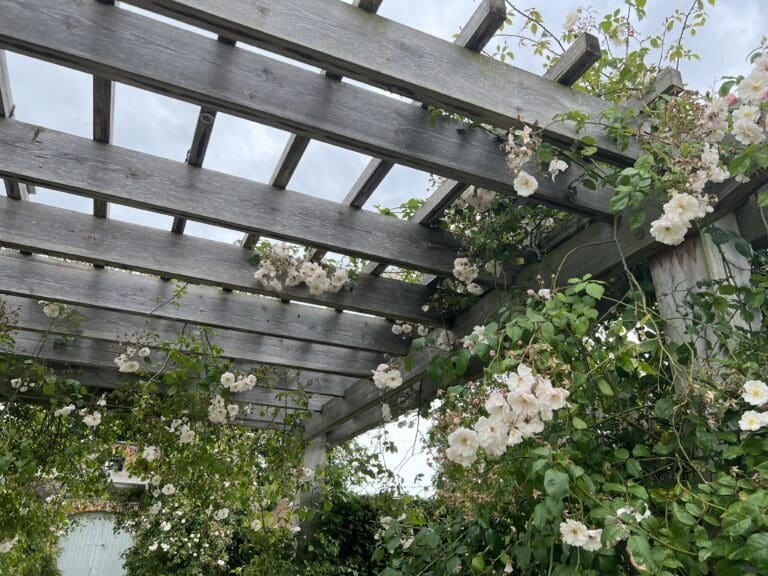If you’re looking to add a touch of charm and elegance to your garden in the UK, a garden arch adorned with climbing plants might be the perfect solution.
This simple addition can turn an ordinary space into something truly special, creating a focal point that captures attention and adds depth to your outdoor area.
The combination of a sturdy arch with the natural beauty of climbing plants can evoke a sense of wonder, leading the eye and enticing visitors to explore further. In this post we will outline some of the best plants for your garden arch this year.
Top Tip
Consider the potential growth and weight of climbing plants for your garden arch, ensuring that the structure can support them as they mature, to avoid any stability issues down the line.
The Best Climbing Plants for Your Garden Arch
- Wisteria
- Honeysuckle
- Clematis
- Jasmine
- Passion Flowers
- Grapevines
- Climbing Roses
- Ivy
- Trumpet Vine
- Sweet Peas
1. Wisteria

Wisteria creates a spectacular effect with its cascading purple or white blooms. Thriving best in sunny positions, it’s suited to south or west-facing gardens with well-drained soil. Deciduous in nature, wisteria sheds its leaves in winter but returns each spring. Careful pruning, twice a year, is essential to prevent damage due to its weight.
2. Honeysuckle
Honeysuckle charms with sweet-smelling tubular flowers and attracts pollinators. It can be either deciduous or evergreen, depending on the variety, and grows well in full sun to partial shade. Annual pruning controls its growth, and its fragrant blooms make it a favourite for garden arches.
3. Clematis

Clematis comes in a wide array of vibrant flowers and is usually a perennial, returning every year. Planted in well-drained soil in a sunny, wind-sheltered location, it will thrive. Different pruning needs are determined by its specific group, making clematis a diverse addition to any garden.
Pruning requirements depend on the clematis group to ensure optimum performance:
Group 1 clematis: Early flowering in winter and spring on previous year’s growth; no pruning required.
Group 2 clematis: Large flowers bloom in spring and summer on previous year’s growth; prune in February.
Group 3 clematis: Late flowering on the current season’s growth; cut back to approximately 2 feet in February or March.
4. Jasmine
Jasmine is known for its star-shaped and highly fragrant flowers. Depending on the variety, it can be either deciduous or evergreen. It prefers a sunny position and well-drained soil, with light trimming in September to maintain its shape.
5. Passion Flower

Passion Flowers provide a tropical touch with their exotic appearance. Most are perennial and come back each year. Growing in well-draining soil and plenty of sun, they require annual pruning after flowering. Their exotic appearance makes a garden arch a stunning focal point.
6. Grapevines

Grapevines offer appealing clusters of grapes and large, lobed leaves. Being deciduous, they return yearly but shed their leaves in winter. Thriving in a sunny spot with good drainage, they are low maintenance but benefit from annual trimming.
7. Climbing Roses

Climbing Roses add elegance and are perfect for a cottage-style garden. These perennial plants return every year, and while not evergreen, they provide seasonal beauty. Growing in sunny locations with well-drained soil, annual pruning maintains their charm.
8. Ivy

Ivy provides year-round beauty with evergreen leaves in various shapes and shades. Highly adaptable, it requires occasional pruning to prevent it from becoming too dense. Its evergreen nature ensures a lush appearance throughout the year.
9. Trumpet Vine
Trumpet Vine, with trumpet-shaped orange or red flowers, adds a splash of colour. This perennial plant returns each year and prefers a sunny location with well-drained soil. Growing quickly, pruning is essential to manage its vibrant growth.
10. Sweet Peas

Sweet Peas are known for their soft pastel-shaded fragrant flowers. They are typically grown as an annual, meaning they complete their life cycle in one year. Sweet Peas thrive in sunny positions with rich, well-drained soil. Regular deadheading encourages more blooms.
Key Considerations for Growing Plants Over Your Garden Arch
Weight
It’s vital to consider the weight of the climbing plants to ensure that your garden arch remains stable and safe. Vigorous growth and dense foliage can add considerable weight, especially when wet. Choosing plants that suit your arch’s size and strength is crucial. If your arch is smaller and less robust, opting for lighter or less vigorous plants is wise. Regular pruning and training can help maintain the plant’s size and shape, further ensuring safety and aesthetics.
Maintenance
Maintenance is another factor that requires careful thought. Many attractive climbers, such as ivy, wisteria, and grapevines, grow quickly and will need regular pruning. Consider whether you have the time and resources to undertake this necessary task annually or more often, depending on the species.
Competition for light
Keep in mind that a dense canopy of climbing plants can change light levels for the other plants in your garden. This might affect their growth, health, and the overall appearance of your garden space. Regular pruning is essential to control the size of your climbing plant and to ensure it doesn’t overtake the arch or cast unwanted shade on other beloved garden plants.
Garden theme
Choose climbing plants that complement the overall theme and aesthetic of your garden. From rustic charm to modern elegance, the right plants can enhance your garden’s look. Consider the colour, texture, and seasonal changes of the climbing plants.
Plant Type and Life Cycle
Understanding whether a plant is an annual, perennial, evergreen, or deciduous will influence its appearance and maintenance throughout the year. Your choice may affect how the arch looks across different seasons.
Planning ahead with these considerations in mind can save you considerable time, effort, and even money. By ensuring that your garden arch is robust enough to support the chosen plants and that you can manage the required maintenance, you’ll set yourself up for success. This thoughtful approach will help you create a beautiful, living feature in your garden that provides pleasure and interest year after year.
Final thoughts
From the cascading blooms of Wisteria to the fragrant blossoms of Honeysuckle, each plant adds unique beauty and character. However, it’s essential to consider aspects like the potential weight of the plant, maintenance needs, and the plant’s impact on light levels in your garden.
Remember, the list provided in this article is not exhaustive. Many other climbing plants might be perfect for your garden arch, each with its special charm and requirements. Use this guide as a foundation in your journey to craft the garden of your dreams, always considering your local climate, soil conditions, and the specific position of your arch.
A garden arch adorned with flourishing plants doesn’t just add visual appeal but can become a sanctuary for various wildlife, enhancing your garden’s biodiversity. The choice of climbers can transform a simple arch into a living artwork that evolves with the seasons, providing both sensory delight and a natural habitat.
Frequently Asked Questions
Q. What is the best clematis for an arch?
The best clematis for a garden arch often depends on personal preference and specific garden conditions. A popular choice is Clematis ‘Nelly Moser,’ which blooms with large pale pink flowers and is known for its robust growth and adaptability. Clematis montana varieties are also favoured for their vigorous growth and beautiful, fragrant blossoms.
Q. How do I support climbing plants on my garden arch?
Supporting climbing plants on a garden arch usually requires a combination of physical supports like trellises or wires and regular pruning and training. Many climbers will naturally twine around or cling to the structure, but some might need tying in their early stages. Using soft garden twine or specialized plant ties can guide the plant in the desired direction without damaging the stems.
Q. Can I grow fruit-bearing climbers on a garden arch?
Yes, many fruit-bearing climbers can be grown on a garden arch. Grapevines are a popular choice, providing not only attractive foliage but also delicious grapes. Kiwi vines and some varieties of raspberry can also be trained over an arch. Keep in mind the specific care and pruning requirements for fruit-bearing plants to ensure a healthy crop.



